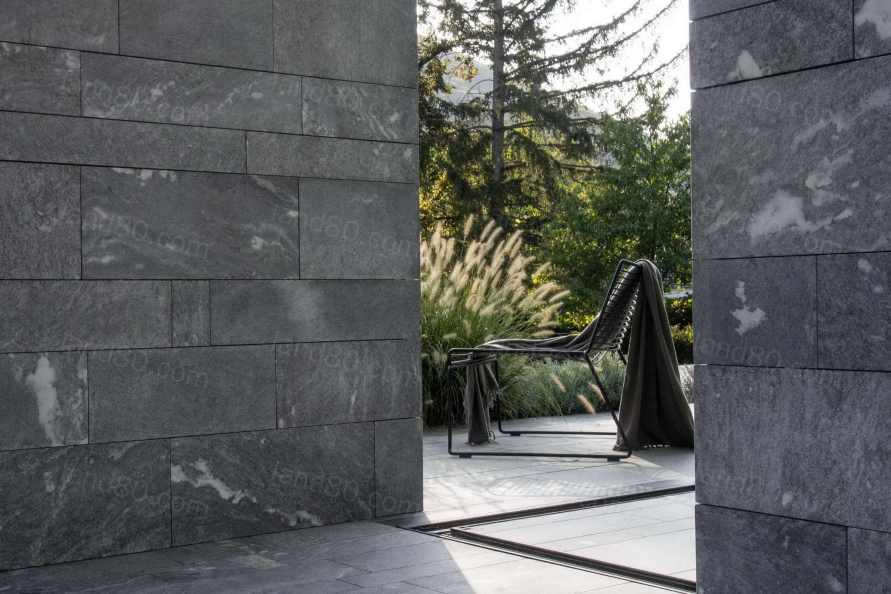在奥地利,对于装饰着棕榈树和霓虹灯的地下室酒店水疗中心来说,"健康Spa"是一个最常用的营销词,然而,在Hinterbrühl村,一个新的私人水疗中心创造了一个21世纪的放松寺庙。第一眼看去,并没有发现这个建筑是专门为Spa而建的,但它却包含了Spa所有需要的配套设施。
In Austria, the catchall marketing phrase for a basement hotel spa decorated with palm trees and neon lights is a “wellness temple”. Here in the village of Hinterbrühl, however, a new private spa has created something very special indeed: a 21st-century temple of relaxation. A first glance doesn’t reveal that the structure is dedicated to the cult of the bathhouse, and yet it includes all the signature features—from jacuzzi to steam bath.


温泉馆位于场地的后方,在场地上老别墅的对面,浴场与主屋之间的坡度非常小,足以在浴场和世纪初的别墅之间形成视觉上的隔离。项目主要使用了Rauris石英石这一种天然石材,可以抵御蒸汽、氯气、桑拿房的高温以及冬天的霜冻而不损坏。竖板看起来不像墙,横板也不像屋顶,这种印象来自于墙体从天花板板上穿孔延伸的方式,完全避免了任何支撑作用,使屋顶元素看起来像漂浮在空中。
The spa pavilion is located at the back of the grounds, across from the old villa. The slope from the main house is very slight—just enough to create a visual separation between the bathhouse and the turn-of-the-century villa. It is composed of a single material, like a sculpture: Rauris quartzite, a natural stone, can withstand steam, chlorine, the heat of the sauna, and the winter frost without damage. The vertical slabs don’t look like walls, nor the horizontal ones like roofs, an impression that arises from the way the walls perforate and extend from the ceiling slabs, fully avoiding any suggestion of a supporting role and making the roof elements seem to float.
视线从内向外
在长方形的三维网格中,石板似乎并不是组装起来的,而像是相互堆叠的,这些相互作用形成了各种功能的空间和壁龛,并根据需要打开或遮挡视线,这使得室内与周围的绿化自然交流,创造了一个整体的空间体验。虽然亭子的四面都是开放的,但非常谨慎的面板排列创造了绝对的隐私。在夏季,人们无法想象还有什么比这更开放的建筑,在冬天,隐藏在墙面和天花板上的玻璃板可以滑出并覆盖亭子。浴场是私密的,人们可以在任何季节和任何着装状态下在按摩浴缸、蒸汽浴、桑拿、淋浴、泳池、日光浴和酒吧之间游走。
Looking Out but Not In
Set within the rectangular, three-dimensional grid, the slabs of stone seem not to be assembled, but rather placed in relation to one another. These interactions form spaces and niches for the various features, opening or obscuring views as needed. This allows the interior to naturally communicate with the surrounding greenery—and a holistic spatial experience is created. While the pavilion is open on all four sides, the very careful alignment of the panels creates absolute privacy. In the summer, one can’t imagine a more open building. In the winter, glass panels hidden in the wall and ceiling slide out and over the pavilion. The bathhouse is private—one can wander between the jacuzzi, steam bath, sauna, shower, pool, sundeck, and bar in any season and in any state of dress.




石材质的统一
吧台后面的楼梯将人引入地下通道,地下通道连接别墅和Spa馆。这里曾被用作保龄球馆,而现在现在玻璃元素构成了细长的管子,标记了不同的区域。Rauris石英岩与垂直的苔藓植物一起创造了一种有节奏的和谐,在建筑上将地下健身房和地上澡堂结合在一起。
Stone Unifies
A staircase behind the bar descends to a former underground passageway connecting the villa and the bathhouse, which was previously used as a bowling alley. Glass elements now structure the elongated tube, marking the various exercise areas. The Rauris quartzite creates a rhythmic harmony together with the vertical moss plantings, architecturally uniting the underground gym with the aboveground bathhouse.




项目内的单体板块以不同的方式划分空间,创造出不同的视角,增强了空间体验和户外氛围,同时,各个区域也共同构成了一个更大的更开放的温泉建筑。迷宫式平面布局避免了对称性和重复性,也打造了一个清晰的空间结构。这是一个“多维度”的空间,没有明确的内外界限,但也是一个不从属于纯粹的功能主义。项目可以从两个方面来解释,一方面,它遵循了现代主义的传统,精简了设计语言,使空间功能变得生动清晰,然而,它也是一个特殊的案例,将代表宗教的 "寺庙"与温泉结合在一起,一个以崇拜为目的的现代功能建筑,使Spa回到了古代赋予它的神圣意义。
The monolithic slabs of the pavilion structure the space in different ways, creating a variety of perspectives, directions, characteristics, spatial experiences, and outdoor interactions. At the same time, the individual zones also come together to form a large, open spa architecture. The labyrinthine nested floor plan dispenses with symmetry and repetition, instead surprising with its structure. The result is a fitness area with a clear structure and a bathhouse that doesn’t dictate a specific direction, instead placing the experience itself in the foreground. This is a multidimensional space, without clear boundaries between outside and inside, but also a stone monument that does not subordinate itself to pure functionalism, instead standing for itself—for its own existence and meaning. The bathhouse can be interpreted in two ways: On the one hand, it follows the modernist tradition of using a reduced formal vocabulary to make the functions vividly clear and spatially tangible. However, it is also a shining example of what entices us to speak of “cult” and “temple” in conjunction with spas. A modern functional building for a cult purpose, returning to the bathhouse a piece of the sacredness attributed to it in antiquity.


Project name: “Contemplative Aesthetics” - spa pavilion, Hinterbrühl
Company name: Smartvoll Architekten
Website: www.smartvoll.com
Contact e-mail: office@smartvoll.com or schaberl@smartvoll.com
Project location: Hinterbrühl, Austria
Completion Year: 2020
Building area (.0m²): Pavillon 100m2 / Outdoor 300m2 / Fitness Tunnel 80m2
Photo credits: Dimitar Gamizov | Anton Klyshnia
|